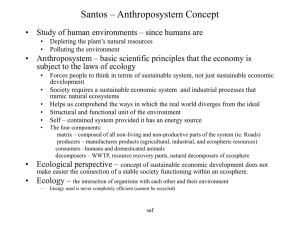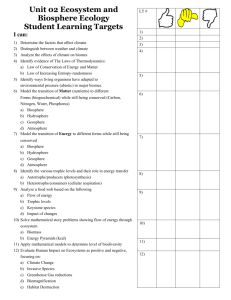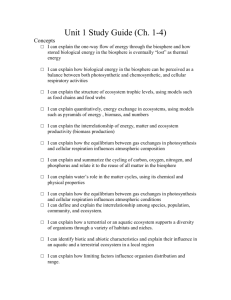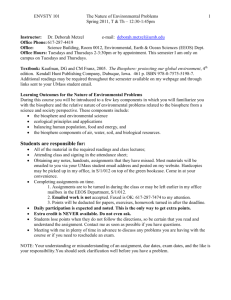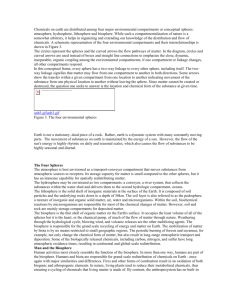ECOSYSTEM AND THE BIOSPHERE: Metaphors for
advertisement
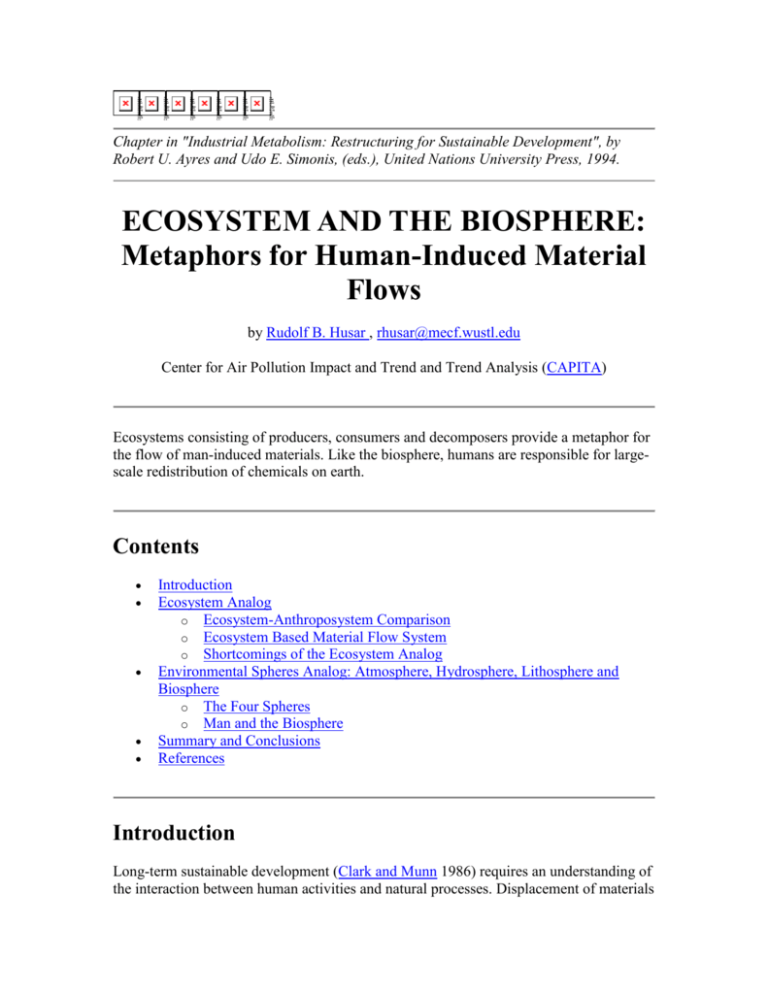
Chapter in "Industrial Metabolism: Restructuring for Sustainable Development", by Robert U. Ayres and Udo E. Simonis, (eds.), United Nations University Press, 1994. ECOSYSTEM AND THE BIOSPHERE: Metaphors for Human-Induced Material Flows by Rudolf B. Husar , rhusar@mecf.wustl.edu Center for Air Pollution Impact and Trend and Trend Analysis (CAPITA) Ecosystems consisting of producers, consumers and decomposers provide a metaphor for the flow of man-induced materials. Like the biosphere, humans are responsible for largescale redistribution of chemicals on earth. Contents Introduction Ecosystem Analog o Ecosystem-Anthroposystem Comparison o Ecosystem Based Material Flow System o Shortcomings of the Ecosystem Analog Environmental Spheres Analog: Atmosphere, Hydrosphere, Lithosphere and Biosphere o The Four Spheres o Man and the Biosphere Summary and Conclusions References Introduction Long-term sustainable development (Clark and Munn 1986) requires an understanding of the interaction between human activities and natural processes. Displacement of materials by industrial and agricultural activities causes the most severe anthropogenic stress on the natural system. Hence, the understanding of human-induced material flows and the comparison of those to natural flows is a major step toward the design and evaluation of sustainable development. A major component of the understanding of human-induced material flows is the identification of the key players and driving forces involved, i.e. the building of a conceptual model. Initially, such a model does not need to be predictive; it is sufficient for it to have explanatory power for the existing human-nature interaction. In formulating and explaining such conceptual models, it is helpful to use established systems as a guide. Applying metaphors and analogies, transfers existing knowledge and concepts to the questions under consideration. Natural systems have demonstrated ability for sustained development and provide a rich choice for selecting useful metaphors for the description of human activities. Industrial metabolism is a powerful metaphor for the illumination of the processes that mobilize and control the flows of materials and energy through industrial activities. As in nature, industrial "organisms" consume "food" for the maintenance of their functions and exhale waste products (Ayres, 1992). The industrial metabolism metaphor has the organism as its main biological entity and industrial organizations as their human analogues. These are proper entities for the study of the internal workings of metabolism within these organisms. However, both the causes as well as the consequences of metabolism lie beyond the confines of an organism. These depend on the external world that includes other organisms as well as the physicochemical environment. This short chapter builds on the strength of the industrial metabolism metaphor and discusses the possible applicability of the ecosystem and the biosphere as extended biological analogues for human activities. The goal here is to offer multiple, complementary points of view to describe through analogues the same topic: humaninduced mobilization of materials. Hopefully, this will contribute to the illumination of this multi-faceted and important process. Back to Contents Ecosystem Analog An ecosystem is a biotic assemblage of plants, animals, and microbes, taken together with their physico-chemical environment (e.g. Kormondy, 1969). In an ecosystem the biological cycling of materials is maintained by three groups: producers, consumers, and decomposers (Figure 1a). The producers are plants and some bacteria capable of producing their own food photo synthetically or by chemical synthesis. The consumers are animals that obtain their energy and protein directly by grazing, feeding on other animals, or both. The decomposers are fungi and bacteria that decompose the organic matter of producers and consumers into inorganic substances that can be reused as food by the producers; they are the "recyclers of the biosphere". Nature is capable of sustaining the producer-consumer-decomposer cycle indefinitely with the sun as the energy source. The smallest such entity that is self-sufficient is an ecosystem. Figure 1. Movement of chemicals and materials through the (a) natural ecosystem and (b) a system resulting from human activity, anthroposystem. Functionally, human activities that perturb the natural environment can also be divided into three similar components (Figure 1b). Producing activities include energy production (fossil fuels), manufacturing (non-fuel minerals), and growing food. The consumers are humans and their domestic animals. Decomposing or recycling activities include treatment of waste water, recycling of metals and solid wastes. However, whereas an ecosystem relies on its decomposers for a complete recycling of its elements, the anthroposystem lacks such efficient decomposers and recyclers. As such, manufactured materials that are no longer needed and waste by-products of industrial activity are largely disposed into the physical environment. The process of adding unwanted materials to the environment is called pollution. The waste by-products are disposed by the atmosphere and the hydrosphere, and delivered to the biological and geochemical receptors. In this sense, the anthroposystem, as defined above, is an open system, as discussed by Ayres, in this volume. Ecosystem-Anthroposystem Comparison The producer-consumer-recycler model provides a convenient framework for comparing ecosystems to anthroposystems. The flow of materials in both systems is illustrated qualitatively by the arrows in Figures 1a and 1b. In an ecosystem most of the materials are transferred from the producers (plants) to the recyclers (bacteria), and only a small fraction is passed through the consumers to the recyclers. The decomposers (recyclers) return most of the materials to the producers for reuse. In the anthroposystem the flow from the producers to the recyclers is small or even nonexistent since it would be pointless to produce (mobilize) materials and immediately recycle them without a consumer in the loop. In the anthroposystem much of the mobilized materials are transferred to the rest of the material environment, to the producer and to the consumer. Hence, it is mostly an open system, where recycling accounts for only a small fraction of the mobilized matter. In an ecosystem, sustained development (evolution) is facilitated by a close physical proximity and functional matching between the producers and the consumers. The physical proximity of producers, consumers and recyclers (e.g. plants, animals, and bacteria in a forest) assures that very little energy is required for the physical transport of matter (here: between the plant and its symbiotic bacterial population). Also, the physical proximity allows a reasonably fast mutual adjustment given a perturbation in the system. In the anthroposystem, there is usually a significant physical displacement between the producer and the consumer. The global flow of oil products is the most dramatic example. Accordingly, a significant amount of energy is required to transfer the matter to the producer or to a recycler. This physical separation of producers, consumers and recyclers is a major difference between the ecosystem and the anthroposystem. The producer-consumer-recycler model is a suitable framework for economic models to study the driving forces of the material flows. It is self evident that the allocation of material resources will depend on the production (supply), the consumption (demand), and the cost at the receptor. The ecosystem - model, as described above, can also be used to formulate physicochemical models based on mass conservation principles. The next section presents such a formulation. Ecosystem Based Material Flow System The flow of matter from the producers to the consumers, and subsequently to the receptors is depicted schematically in Figure 2. Most of the production of potential pollutants begins with mining, that is, the removal of a substance from its long-term geochemical reservoir. The pollutant mass, Mi, mobilized by mining (tons/yr) is the production rate Pi (tons/yr) of the raw material (coal, oil, smelting ore, etc.) multiplied by the concentration ci (gram/ton) of the impurity (sulfur, mercury, lead, etc.): Mi = ciPi. Matter is transferred from the producer to the consumer by transportation, including railroads, trucks, and ships. Functionally, transportation redistributes the mobilized substances over a large geographical area and to a multiplicity of consumers. Every producer, i, may deliver its product to any consumer, j. Mathematically, this producerconsumer transfer is characterized by a surface transfer matrix, sij. The amount of matter, Uij, originating from producer i and used at consumer j is sijMi. The total amount of matter reaching the consumer j is the sum of the matter produced by all producers multiplied by their respective surface transfer matrix elements. The next transfer occurs between the consumer (or emitter) and the environmental receptors. The consumer is located where the combustion or smelting occurs, the receptor is located where the pollutant is deposited, following its atmospheric or hydrologic transit. Again, consumer j can transfer matter through the atmosphere to a receptor k. Hence, the matter received at receptor k that originated at consumer (emitter) j, Rjk, is the product of the use rate Uj times the atmospheric or hydrologic transfer matrix, ajk, from consumer (emitter) j to receptor k. The total amount of matter deposited at receptor k is the sum of the use rates Uj at each emitter weighed by its atmospheric/hydrologic transfer matrix element. In this chapter, the numeric values of the Mi, ci, and sij are discussed in some detail; discussion of the atmospheric transfer matrix ajk, however, is beyond the scope of this report. Figure 2. Illustration of key matrices in the flow of materials from the producer to the consumer to the receptor The release of a substance at any given emission site Uj (tons/yr) is as follows: Uj = sijciPi. (It is to be noted that in this simplified formulation, the releases are not broken down by media, i.e. air, land, and water; a general approach to include the transfer through all environmental media is presented in the next section: The Environmental Spheres Analog. An illustration of such a model is given in Husar (1986) as applied to the mobilization and transfer of sulfur in the United States from its geochemical reservoirs (by mining), to the consumers at the power plants, and subsequently to the receptors and receiving geochemical reservoirs). Shortcomings of the Ecosystem Analog The ecosystem model of nature and of human activities described above has a major shortcoming in that it gives little regard to the physical transfer of mobilized matter. It does not address where the redistribution occurred. Also, in that model, much of the anthroposystem had to be left open since many of the flows out of the system as waste products. The next section is an attempt to extend the ecosystem analog by "closing the system". In such a scheme, materials are accounted for regardless of where they move after leaving a given open system. Back to Contents Environmental Spheres Analog: Atmosphere, Hydrosphere, Lithosphere and Biosphere Chemicals on earth are distributed among four major environmental compartments or conceptual spheres: atmosphere, hydrosphere, lithosphere and biosphere. While such a compartmentalization of nature is a somewhat arbitrary, it helps in organizing and extending our knowledge of the distribution and flow of chemicals. A schematic representation of the four environmental compartments and their interrelationships is shown in Figure 3. The circles represent the spheres and the curved arrows the flow pathways of matter. In the diagram, circles and curved arrows are used instead of boxes and straight line connections to emphasize the close, dynamic, inseparable, organic coupling among the environmental compartments; if one compartment or linkage changes, all other compartments respond. In this conceptual frame, every sphere has a two-way linkage to every other sphere, including itself. The two-way linkage signifies that matter may flow from one compartment to another in both directions. Some arrows show the transfer within a given compartment from one location to another indicating movement of the substance from one physical location to another without leaving the sphere. Since matter cannot be created or destroyed, the question one seeks to answer is the location and chemical form of the substance at given time. Figure 3. The four environmental spheres The Four Spheres The atmosphere is best envisioned as a transport-conveyer compartment that moves substances from atmospheric sources to receptors. Its storage capacity for matter is small compared to the other spheres, but it has an immense capability for spatially redistributing matter. The hydrosphere may be envisioned as two compartments: a conveyor, a river system, that collects the substances within the water shed and delivers them to the second hydrologic compartment, oceans. The lithosphere is the solid shell of inorganic materials at the surface of the Earth. It is composed of soil particles and the underlying rocks down to a depth of 50km. The soil layer is also referred to as the pedosphere, a mixture of inorganic and organic solid matter, air, water and microorganisms. Within the soil, biochemical reactions by microorganisms are responsible for most of the chemical changes of matter. However, soil and rock are mainly storage compartments for deposited matter. The biosphere is the thin shell of organic matter on the Earth's surface. It occupies the least volume of all of the spheres but it is the heart, or the chemical pump, of much of the flow of matter through nature. Weathering through the hydrological cycle, blowing wind, and volcanic releases are the other mobilizing agents. The biosphere is responsible for the grand scale recycling of energy and matter on Earth. The mobilization of matter by biota is by no means restricted to small geographic regions. The periodic burning of forests and savannas, for example, not only change the chemical form of matter, but also result in long-range atmospheric transport and deposition. Some of the biologically released chemicals, including carbon, nitrogen, and sulfur have long atmospheric residence times, resulting in continental and global-scale redistribution. Man and the Biosphere Human activities most closely resemble the function of the biosphere. In more than one way, humans are part of the biosphere. Humans and biota are responsible for grand-scale redistribution of chemicals on Earth - once again with major similarities and differences. Fires and other forms of combustion result in an oxidation of both biogenic and athropogenic elements. In nature, living plants tend to reduce their metabolized chemicals, thus ensuring a cycling of chemicals that living matter is made of. By contrast, the anthroposystem has no built-in mechanisms for reducing oxidized compounds. Rather, man-induced oxidation products have to rely on biota for reduction, i.e recycling. Given the limited reduction capacity of the biosphere, many of the combustion products remain in stable oxidized form and are ultimately deposited in another long-term geochemical reservoir. The atmosphere and the hydrosphere are effective conveyors of matter. Consequently, many of the anthropogenic chemicals are transferred to the land or the oceans where they are subsequently incorporated in these long-term geochemical reservoirs. Much of the environmental damage is done in the atmosphere, hydrosphere, lithosphere and biosphere during the transit from one long-term geochemical reservoir to another. Back to Contents Summary and Conclusions In the "industrial metabolism" metaphor industrial organizations are likened to biological organisms that consume food and discard waste products. This short chapter builds on and extends this metaphor beyond the biological organisms to an entire ecosystem. The human analog of the ecosystem is the anthroposystem, consisting of producers, consumers, and recyclers. Using these components, both ecosystem and anthroposystem are described by a conceptual material flow model that is also a suitable framework for an economic model. It is noted that the current anthroposystem differs from an ecosystem mainly in that it lacks the efficient material recyclers that allow sustainable development. In this sense, the anthroposystem is an open system, and the analogy with an ecosystem is incomplete. The environmental spheres analogy extends the ecosystem analogy further by considering the flow of matter in all environmental compartments or conceptual spheres, i.e. air, land, water, and biota. This extension allows a closing of the system by following the flow and fate of matter regardless of the location and medium of transfer. It is concluded that human activities most closely resemble the role of the biosphere in the mobilization of matter. The above multimedia approach to material flows lends itself to rigorous mathematical formulation. In fact, it could be combined with the ecosystem approach presented in the previous section. The resulting model would encompass the complete, end-to-end flow analyses from the time of "production", i.e. removal from a geochemical reservoir, to its fate in the receiving reservoir. Such a multimedia physical model would also be a suitable framework for environmental economic analysis. Back to Contents REFERENCES Ayres, R.U.: Industrial Metabolism Theory and Policy, in this volume. Husar, R.B.: Emissions of Sulfur Dioxide and Nitrogen Oxides and Trends for Eastern North America. In "Acid Deposition Long-Term Trends". National Academy Press, Washington, DC, 1986. Husar, R.B. and J.D. Husar,: Sulfur. In : B.L. Turner II, W. C. Clark, R. W. Kates, J. F. Richards, J. T. Mathews, and W. B. Meyer, (eds.) "The Earth as Transformed by Human Action." Cambridge University Press, Cambridge, !990. Kormondy, E.J.,: "Concepts of Ecology." Prentice-Hall Biological Science Series, Prentice-Hall,Inc., Englewood Cliffs, NJ, 1969. Clark, W.C. and R.E. Munn (eds): "Sustainable Development of the Biosphere". Cambridge University Press, Cambridge, 1986. * Acknowledgment. The author acknowledges the contributions of Janja D. Husar in the review and preparation of this manuscript. Back to Contents Submit Comments Submit your comments, feedback, questions, and ideas pertaining this page. Your input will be automatically added to the existing annotations. In order to add a new comment, you must be registered with the CAPITA People's Page. support@capita.wustl.edu
